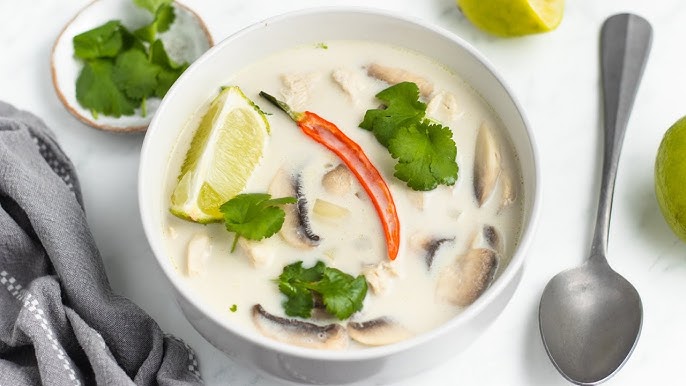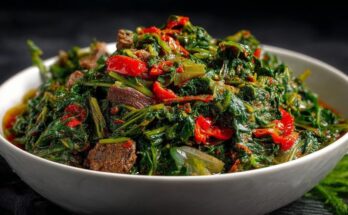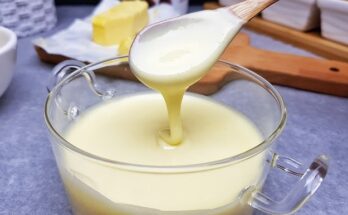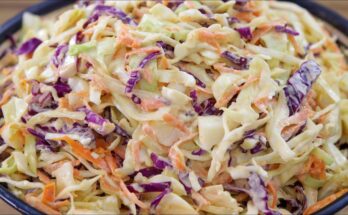Tom Kha Gai Recipe: Tom Kha Gai is not just any soup—it’s a Thai culinary gem that has warmed hearts and delighted taste buds around the world. Known for its creamy, coconut-rich base balanced by the tang of lemongrass and the heat of fresh chilies, this dish is the perfect combination of spicy, sour, salty, and sweet. “Tom” means boil, “Kha” means galangal (a cousin to ginger), and “Gai” means chicken. So, at its core, this is a boiled chicken soup infused with galangal.
What makes Tom Kha Gai so unique isn’t just its ingredients, but how they’re layered together to create depth and complexity. It’s comfort food in Thailand, often served as a starter in meals or even as a main course when paired with rice. The delicate balance of flavors represents everything that Thai cuisine stands for—vibrancy, contrast, and freshness.
If you’ve ever wanted to bring authentic Thai flavor to your kitchen, this step-by-step Tom Kha Gai guide is your perfect starting point. Whether you’re a seasoned cook or a curious beginner, you’ll find this recipe not only easy to follow but incredibly satisfying to make.
Ingredients You’ll Need
Let’s start with the essentials. One of the beautiful things about Thai cuisine is that even a seemingly complex dish like Tom Kha Gai can be created with a simple list of ingredients—provided they’re the right ones. Here’s what you’ll need:
Main Ingredients:
- 2 cups of coconut milk (full fat for richness)
- 1 cup of chicken broth (or water if you want it lighter)
- 1 stalk of lemongrass (cut into 3-inch pieces and smashed)
- 4-5 slices of fresh galangal (or ginger if unavailable)
- 3-4 kaffir lime leaves (torn for flavor release)
- 200 grams of chicken breast or thigh (sliced thin)
- 1 cup of mushrooms (straw mushrooms or button mushrooms work well)
- 2-3 Thai bird’s eye chilies (smashed)
- 2 tablespoons of fish sauce
- 1 tablespoon of lime juice
- 1 teaspoon of sugar
- Fresh cilantro for garnish
Substitutes and Alternatives:
Don’t worry if you can’t find everything. Galangal can be subbed with ginger, although it changes the flavor slightly. Kaffir lime leaves might be swapped with a bit of lime zest. If you can’t find Thai bird’s eye chilies, use red chili flakes or jalapeños. The key is to aim for balance in flavor.
Pro tip: Try to source these ingredients from an Asian grocery store for the most authentic taste. Freshness matters a lot in this recipe, especially when it comes to herbs and aromatics.
Kitchen Tools and Preparation Tips
Before diving into the cooking, let’s get your kitchen ready. Good prep makes everything flow smoothly.
Essential Tools:
- Medium-sized saucepan
- Sharp knife
- Cutting board
- Wooden spoon or ladle
- Citrus juicer (optional, but helps)
Prepping the Ingredients:
- Lemongrass: Peel the tough outer layer, then slice and smash it with the flat of your knife to release the oils.
- Galangal: Cut it into thin slices. There’s no need to peel unless the skin looks very tough.
- Chicken: Slice it thin for quicker cooking and tenderness.
- Mushrooms: Wash and halve them if they’re large.
- Kaffir Lime Leaves: Tear them to expose the essential oils—they’ll be removed before serving.
Doing this ahead of time ensures the cooking process is stress-free and quick. Thai cooking is all about timing and freshness, so having everything ready to go before the heat turns on is a smart move.
Step-by-Step Cooking Instructions
Now for the fun part—bringing all those vibrant Thai flavors together in one delicious bowl.
Step 1: Prepare the Broth
Start by pouring the coconut milk and chicken broth into your saucepan and bringing it to a gentle simmer over medium heat. Stir occasionally to keep the coconut milk from separating. This creamy base is going to carry all the other flavors, so treat it with care.
Step 2: Infuse with Herbs
Once the broth is hot, add the smashed lemongrass, sliced galangal, and torn kaffir lime leaves. Let these simmer for about 5-7 minutes. This is where the magic starts—the broth begins to take on the bright, citrusy, and peppery notes that make Tom Kha Gai so unique.
Step 3: Add the Protein
Now, drop in your sliced chicken and mushrooms. Keep the heat at a gentle simmer to avoid overcooking the meat. Stir gently and cook until the chicken is just done—usually about 5-7 minutes. The chicken will soak up all those flavors, becoming juicy and aromatic.
Step 4: Final Touches
Turn off the heat and stir in the fish sauce, lime juice, sugar, and smashed chilies. Give it a taste—you should get a delightful punch of sweet, sour, salty, and spicy. Adjust as needed. Maybe a little more lime? A splash more fish sauce? This is your moment to make it truly yours.
Remove the lemongrass, galangal slices, and kaffir lime leaves before serving. They’re flavorful but not fun to chew on.
Serving Suggestions
Tom Kha Gai is best enjoyed piping hot, served in a deep bowl with a generous garnish of fresh cilantro. Pair it with a bowl of steamed jasmine rice if you’re having it as a main course. Want to take it up a notch? Serve it alongside crispy Thai spring rolls or a green papaya salad for a full Thai feast.
To elevate the experience, consider adding a swirl of chili oil on top or a few extra lime wedges on the side. It’s all about balance and customization. Thai food is flexible and friendly—just like this soup.
Health Benefits of Tom Kha Gai
Tom Kha Gai isn’t just delicious—it’s packed with health benefits that make it a nourishing choice for body and soul. The ingredients used are natural immune boosters and have anti-inflammatory properties, making this soup a comforting remedy, especially when you’re feeling under the weather.
Coconut milk, for example, is rich in healthy fats known as medium-chain triglycerides (MCTs), which can aid in weight management and provide a quick source of energy. Galangal, a star ingredient, is known in traditional medicine for its digestive benefits and anti-inflammatory qualities. It can help soothe an upset stomach and even support gut health.
Lemongrass is another herbal powerhouse with antimicrobial and antifungal properties. It’s also great for digestion and detoxification. And let’s not forget kaffir lime leaves, which are high in antioxidants and known to enhance oral health and immunity.
Adding lean chicken gives the dish a good source of protein without excessive fat, and mushrooms contribute vitamins like D and B-complex along with minerals such as selenium and potassium. Even the chili peppers bring more than just heat—they boost metabolism and are high in Vitamin C.
So if you’re looking for a meal that’s indulgent yet wholesome, Tom Kha Gai is an excellent option that satisfies both taste and nutrition.
Tips for the Perfect Tom Kha Gai Every Time
Let’s face it—there’s a fine line between a soup that’s just good and one that makes your taste buds sing. Here are some expert tips to make sure your Tom Kha Gai hits the mark every single time:
- Don’t Boil the Coconut Milk – High heat can cause it to separate and curdle. Keep your heat medium-low and stir gently.
- Fresh Herbs Over Dried – Always opt for fresh lemongrass, galangal, and kaffir lime leaves. The dried versions don’t carry the same punch.
- Balance is Key – Thai cuisine is all about the harmony of flavors. After adding the final seasonings, taste and tweak until you hit that sweet, sour, salty, spicy combo.
- Don’t Overcook the Chicken – It should be tender, not rubbery. Thin slices cook quickly, so keep a close eye.
- Make It Ahead – This soup often tastes even better the next day as the flavors have more time to meld. Just reheat gently and adjust seasoning if needed.
These small details go a long way in ensuring your homemade Tom Kha Gai can compete with what you’d find in a Thai restaurant.
Common Mistakes to Avoid
Even with a fairly simple recipe, a few common missteps can take your Tom Kha Gai from fabulous to flat. Here’s what to watch out for:
- Skipping Key Ingredients: Galangal and kaffir lime leaves might seem optional, but they define the flavor. Substitutes are okay in a pinch but don’t omit them completely.
- Using Low-Quality Coconut Milk: This can drastically affect the creaminess and taste. Look for brands with high coconut content and few additives.
- Overloading on Spices: More isn’t always better. Especially with chili, it’s easy to overpower the soup. Start small—you can always add more later.
- Boiling the Herbs: Extended boiling can turn delicate herbs bitter. Once infused, remove them to maintain a fresh and balanced taste.
Being mindful of these pitfalls ensures your Tom Kha Gai retains its signature elegance and balance.
Tom Kha Gai Variations to Try
One of the best things about Tom Kha Gai is its adaptability. Don’t be afraid to play around with the ingredients to suit your dietary needs or preferences. Here are a few delicious twists you can try:
- Tom Kha Tofu (Vegan): Swap out the chicken for firm tofu and use vegetable broth instead of chicken broth. Make sure your fish sauce is replaced with soy sauce or a vegan alternative.
- Seafood Tom Kha: Add shrimp, scallops, or even squid for a coastal version of this classic. Seafood cooks quickly and pairs beautifully with the coconut and herbs.
- Spicy Tom Kha: Want more fire? Add more chilies or a spoonful of Thai chili paste (nam prik pao) to deepen the flavor and bring the heat.
- Tom Kha Gai with Noodles: Turn it into a hearty one-bowl meal by adding rice noodles or glass noodles. It’s filling and incredibly satisfying.
Feel free to experiment—Thai food is all about creativity and finding your flavor groove.
Storing and Reheating Tips
If you’ve made a big batch of Tom Kha Gai (and honestly, why wouldn’t you?), storing it properly ensures that you can enjoy it over a few days without losing flavor.
Refrigeration: Store in an airtight container in the fridge for up to 3-4 days. The coconut milk may thicken slightly, but that’s normal.
Reheating: Warm it gently on the stove over medium-low heat. Avoid boiling to keep the coconut milk from separating. If it gets too thick, add a splash of chicken broth or water.
Freezing: You can freeze Tom Kha Gai, but it’s best without mushrooms or herbs as they can get mushy. Freeze the soup base and add fresh ingredients upon reheating for best results.
Pairing Tom Kha Gai with Other Thai Dishes
While Tom Kha Gai can easily stand alone as a main course, pairing it with other Thai dishes can elevate your meal into a culinary journey. Here are some classic Thai pairings that complement the soup beautifully:
1. Jasmine Rice
A bowl of warm, fluffy jasmine rice is the most common companion to Tom Kha Gai. It balances the soup’s richness and helps soak up the flavorful broth.
2. Pad Thai
The sweet-savory profile of Pad Thai pairs nicely with the creamy, tangy notes of Tom Kha Gai. Together, they make a well-rounded Thai dinner.
3. Som Tum (Papaya Salad)
This refreshing and crunchy salad contrasts well with the smooth, warm soup. Its zesty lime, chili, and peanut flavors enhance the Tom Kha Gai experience.
4. Thai Spring Rolls
Whether fried or fresh, spring rolls are great as starters. Dip them in sweet chili sauce and enjoy with a spoonful of Tom Kha Gai for an appetizer combo you won’t forget.
5. Thai Iced Tea
Finish your meal with a sweet and creamy Thai iced tea. It cools the palate and rounds off the spices from your savory course.
Combining these dishes allows you to experience the full spectrum of Thai flavors—from sour and spicy to sweet and salty.
History and Cultural Significance of Tom Kha Gai
Tom Kha Gai has deep roots in Thai culinary history. Originally a variation of a soup that featured galangal and coconut milk, it became more widely known and refined in central Thailand. Unlike Tom Yum (which is sharper and spicier), Tom Kha Gai is mellow and creamy, often preferred by those who enjoy a more balanced, less acidic flavor profile.
Traditionally, the soup was seen as a celebratory or restorative meal—served during special family gatherings or when someone was recovering from illness. The galangal, coconut, and lime made it not just comforting, but also believed to be medicinal.
Today, it’s one of Thailand’s most famous exports and is featured on menus in Thai restaurants all over the world. Its rise to global fame is a testament to the universal appeal of its flavor and texture. Even outside of Thailand, it’s celebrated for its therapeutic warmth, its beautiful aroma, and its soothing character.
Vegetarian and Vegan Alternatives
If you’re plant-based, there’s absolutely no need to miss out on this Thai classic. A few smart swaps will make Tom Kha Gai entirely vegan or vegetarian, without sacrificing much of the signature flavor.
Vegan Protein Options:
- Firm tofu or tempeh (pan-fried or boiled)
- Jackfruit (for a meatier texture)
- Plant-based “chicken” or mock meats
Broth Alternatives:
- Vegetable broth instead of chicken broth
Flavor Adjustments:
- Use soy sauce, coconut aminos, or vegan fish sauce as a substitute for regular fish sauce.
- Add a touch of mushroom powder or dried seaweed for that umami punch.
Despite removing the meat and fish-based elements, the galangal, lemongrass, lime, and coconut milk ensure that your soup remains full of flavor. It’s a testament to the flexibility of Thai cuisine and its ability to cater to all palates and dietary lifestyles.
How to Impress Guests with Tom Kha Gai
Want to wow your dinner guests without spending hours in the kitchen? Tom Kha Gai is the perfect showstopper. Here’s how to make it extra special for your next dinner party:
- Serve It in Coconut Shells – For a restaurant-style presentation, use halved coconuts to serve the soup. It adds a tropical, authentic touch.
- Garnish Thoughtfully – Add a sprig of fresh cilantro, a red chili slice, and a swirl of coconut cream or chili oil on top for visual appeal.
- Explain the Ingredients – A quick storytelling moment about lemongrass, galangal, or kaffir lime leaves will add cultural context and intrigue.
- Make a Multi-Course Thai Meal – Begin with spring rolls, follow with Tom Kha Gai, and end with mango sticky rice for a memorable dining experience.
With minimal effort, you’ll have your guests believing they’ve been transported to a bustling street-side eatery in Bangkok.
FAQs about Tom Kha Gai Recipe
1. Can I freeze Tom Kha Gai?
Yes, but it’s best to freeze the broth without mushrooms or herbs. Reheat gently and add fresh ingredients before serving.
2. What can I use instead of galangal?
Ginger is the best substitute, though it changes the flavor slightly. Galangal has a sharper, more citrusy note.
3. Is Tom Kha Gai spicy?
It can be, depending on how many chilies you use. The heat is customizable to your preference.
4. How long does Tom Kha Gai last in the fridge?
It stays fresh for up to 3-4 days in the refrigerator when stored in an airtight container.
5. Can I make Tom Kha Gai vegetarian?
Absolutely! Swap chicken for tofu and use vegetable broth. Replace fish sauce with a vegan alternative or soy sauce.
Conclusion
Tom Kha Gai is more than just soup—it’s a full-bodied experience of Thai culinary artistry. From its fragrant herbs and creamy coconut broth to its spicy, tangy, and savory undertones, every spoonful tells a story of tradition, balance, and nourishment. Whether you’re making it for a quick weeknight dinner, a soothing sick-day meal, or an exotic dinner party feature, this dish never disappoints.
It’s easy to make, adaptable to all dietary preferences, and brimming with health benefits. What more could you ask for in a bowl of soup? So grab your ingredients, light up your stove, and let the aromas of Thailand fill your kitchen today.



